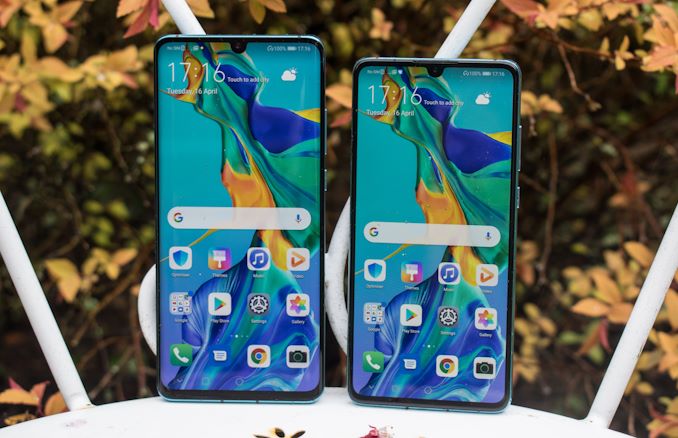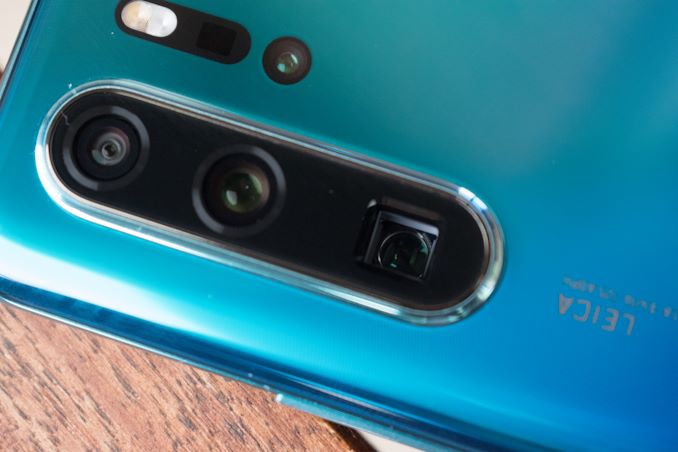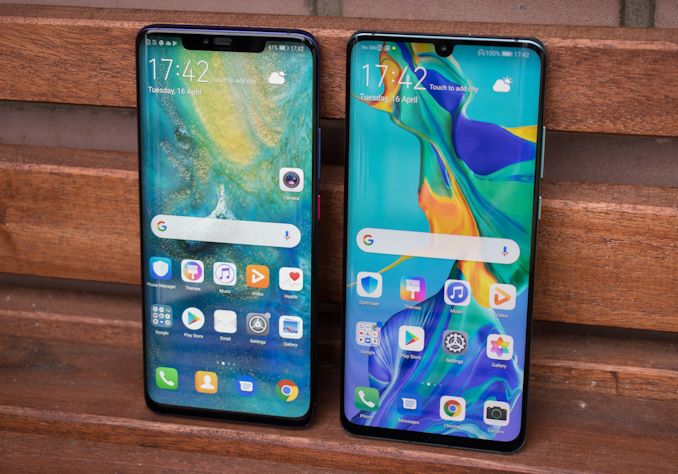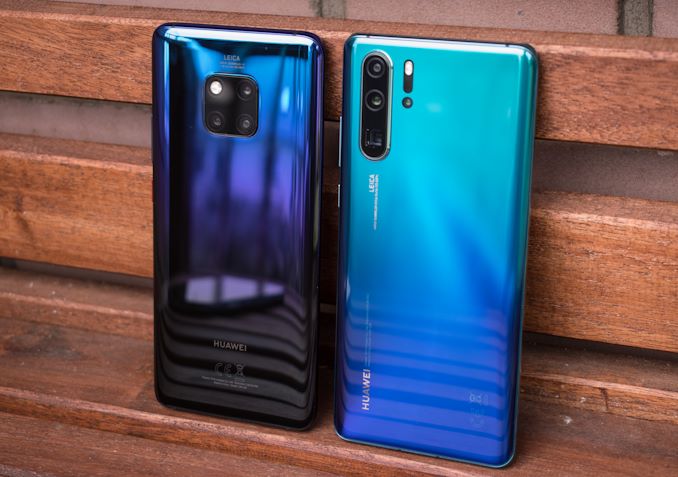The Huawei P30 & P30 Pro Reviews: Photography Enhanced
by Andrei Frumusanu on April 18, 2019 9:00 AM EST- Posted in
- Mobile
- Smartphones
- Huawei
- P30
- P30 Pro
Conclusion & End Remarks
In many ways, the P30 Pro and P30 are both iterative phones. Both devices are taking aspects first introduced in their predecessor P20 series – as well as the sister Mate 20 series – and improving and packaging them into phones with an emphasis on photography.
Design wise, the smaller P30 doesn’t differ all that much from the P20, keeping the same form-factor and also a similar design. Build quality has improved, and the device looks a more premium than its predecessor, mostly due to industrial design changes such the removal of the plastic rim between the body frame and the back glass panel.
Huawei’s choice to go with flat top and bottom frames is quite odd, and it gives the phones a more industrial look and feel than what we’ve become accustomed with compared to the more traditional rounded slab designs.
The bigger P30 Pro adopts the ergonomics of the Mate 20 Pro, meaning it has a curved and flowing display and back cover glass design. I find this design quite fantastic in terms of in-hand feel as well as ergonomics, and it makes the P30 Pro feel like much smaller phone than it actually is. One negative of the new ergonomics is the weight of the phone: at 192g the P30 Pro is a lot heavier than competing devices of its size.
The displays on both P30s are good. Particularly the move to an OLED augments the smaller P30 compared to its predecessor, the LCD-based P20. Huawei was able to seemingly avoid any display issues this time around, as opposed to the concerns of the LG panel units on the Mate 20 Pro. Colour calibration on both phones is good, albeit not excellent. Huawei has achieved better in past models, but it’s not a deal-breaker for the P30s. The only negative about the screens is that I really wish Huawei would have gone 1440p on the P30 Pro – there really is not technical excuse not to adopt it, and it’s just a matter of implementing it correctly.
The dew-drop display notches on the phones are minimal and not intrusive, and I find them better alternatives than what Samsung went with this year.
An odd difference between the two phones is that the P30 has an earpiece speaker while the bigger P30 Pro goes with a piezoelectric under-screen actuator. The problem here is that I just do not see the advantage of these new designs; the earpiece on the P30 is barely visible and sounds better. Unlike Samsung and LG’s recent models, neither of the P30s have stereo playback, and thus lag behind significantly in terms of speaker playback quality. To top off the audio concerns, Huawei continues the senseless design choice of skipping a headphone jack on larger and more expensive P30 Pro while including it on the smaller model..
Both phones have optical under-screen fingerprint sensors, and they’re excellent. The implementation is as good as OnePlus’s, and it’s a much faster sensor than Samsung’s ultrasonic units in the Galaxy S10 series.
The performance of the P30s is excellent thanks to the Kirin 980 SoC. We’ve covered this in past Kirin 980 devices and the new SoC is able to keep up with Qualcomm’s and Samsung’s best for this generation. GPU performance lags a bit behind the flagship competition, but it’s not too bad as it ties in with Snapdragon 845 devices.
Battery life for both phones is excellent, although no longer quite as class-leading, as this title remains with the Mate 20 as well as the new Galaxy S10+.
Cameras Differentiate the P30s
The main selling point of the P-series are supposed to be their cameras, and here Huawei did make some large and interesting changes.
First of all, both P30s now add the wide-angle sensors which were introduced in the Mate 20 series. The additions are fantastic to the shooting experience and Huawei is able to deliver very high quality results, with the P30 Pro having an advantage in quality due to its better sensor.
The zoom optics on the P30 remained the same as what we’ve found on the P20 Pro and Mate 20 Pro – it’s excellent and is able to achieve a higher optical zoom factor than competing devices. Due to the main sensor being 40MP, capturing digitally zoomed in/cropped shots at 2x factor while in 10MP results in little to no quality loss, with the 3x module picking up the slack for further away objects.
While the 5x telephoto module on the P30 Pro is technically impressive in just how far it’s able to go, I’m not very convinced that it’s actually all that beneficial to the everyday capture experience. In particular the device fails to properly bridge the gap between a ~2x and 5x zoom factor, where you’re left with deteriorating image quality and purely digital zooming on the main camera sensor. I honestly do not think that this is how most people use their phones, and I think the 3x zoom on the P30 and previous Huawei devices was a better alternative for the capture experience and most scenarios.
The main camera sensor on the P30s is also interesting. In daylight shots, there are some clear compromises in the new modules. The optics just aren’t as good as what's found on the Mate 20 Pro, and both units suffer from more chromatic aberrations on the outer edges of the images, something that’s immediately visible in the native 40MP capture modes. This issue affects the P30 Pro more than the P30 due to its wider aperture.
Also visible in daylight shots is that detail preservation isn’t as good as the Mate 20 Pro. Besides the optics, this might be caused by the new RYYB sensor which might not have as good pixel isolation as the previous generation sensor.
Daylight processing has changed when compared to the Mate 20 Pro, and while in most cases it’s better, in some cases it also saw regressions. The problem for Huawei is that there’s too large a difference in the processing and resulting images between the different modules. Again I feel as if Huawei putting the responsibility of achieving the best result to the user instead of delivering the best results out of the box. The phones are incredibly versatile in their cameras, but this is also their downfall as they lack consistency.
In low-light scenarios, the P30s are both absolute winners. The new sensor, and particularly the new optics with OIS on the P30 Pro, raise the bar yet again in terms of what one can expect out of a smartphone camera. Huawei’s real only competition here is Google’s Night Sight mode, however once it gets dark enough even the Pixel phones cannot compete with then new Huawei hardware. Compared to other vendors, it’s a completely different league.
Lastly, there’s the question of if the P30 phones are worth their money. Unfortunately I think Huawei’s yet again coming in a little too high on pricing. I have a hard time justifying the P30 Pro’s 999€ price point. The issue here is not only the competition, but also the question of whether this actually represents a better value than say the company’s own Mate 20 Pro, which can now be had for 699€. While impressive, I do not see the 5x telephoto lens as a selling point for the P30 Pro. This leaves the much better low-light capture as the only substantial benefit, as otherwise the P30 Pro represents a downgrade in speaker and display quality, with possibly slightly better battery life.
The P30’s 749€ price seems more reasonable, however again the Galaxy S10 is just 50€ more today, and you’re trading in the excellent low-light capture for an overall better phone.
I think both P30 phones are good devices, however it might be worth to wait a couple of months for the inevitable price drop, as the phones don’t tick all the boxes to be able to justify their launch MSRPs.














85 Comments
View All Comments
hawkie - Friday, April 19, 2019 - link
So advanced and yet still unable to adjust notifications volume separate from ringing volume.s.yu - Friday, April 19, 2019 - link
I know that the volume control of some apps are just broken, for example Wechat will destroy your hearing passing the ringtone through the earphones at maximum volume if somebody calls using the VoIP function while you're wearing IEMs listening to music. This app probably has a billion users, it's ****ing ridiculous and extremely annoying.amosbatto - Friday, April 19, 2019 - link
Let's see whether the P30 and P30 Pro pass my standard for what is important in a smartphone:1. Removable battery: No.
1A. If not removable, how hard is it to crack open the case to replace the battery:
Pretty hard. iFixit gives the P30 Pro a repairability score of 4/10. It is very hard to pry open the case without breaking the glass back. In other words you are probably going to throw away this device after 2-3 years when the battery is degraded.
2. How well will it survive drops? Probably not well.
2A. How hard is it to replace the screen and the glass back panel if broken? Hard and expensive.
3. MicroSD slot for memory expansion: No. It has expensive proprietary memory.
4. Can I root the phone? No
5. Can I unlock the bootloader? No
6. Can I install LineageOS? Never. All info on the Kirin SoC is proprietary.
7. How long will Huawei offer updates? 24 months with updates every 2 months, which is decent for Android, but not as good as the Pixel 2 and 3 which will get 3 years of updates or Apple which is 4-5 years.
In other words, I can only expect to use the P30/P30 Pro for 2 years and I can only do what Huawei wants me to do with the phone. I'll pass. Strange how little attention Anandtech pays to these issues in its reviews.
I am now so fed up with the mobile industry, that I preordered the Purism Librem 5, because at least Purism respects my rights as a user.
Andrei Frumusanu - Friday, April 19, 2019 - link
> 4. Can I root the phone? No> 5. Can I unlock the bootloader? No
> 6. Can I install LineageOS? Never. All info on the Kirin SoC is proprietary.
> Strange how little attention Anandtech pays to these issues in its reviews.
Speaking as somebody who used to compile his own kernels on his smartphones; it doesn't matter. I don't even root nowdays. The vast majority of readers will not, and I say that they should not care about these things. There is simply no benefit to the user experience.
> It is very hard to pry open the case without breaking the glass back.
I've opened plenty of glass back phones and replaced the batteries, it's not terribly hard. The glass backs are also a lot tougher than you think.
> 2A. How hard is it to replace the screen and the glass back panel if broken? Hard and expensive.
Glass back is very easy. Screen is something that no phone of the last few years will be easy to replace anymore.
> 7. How long will Huawei offer updates? 24 months with updates every 2 months, which is decent for Android, but not as good as the Pixel 2 and 3 which will get 3 years of updates or Apple which is 4-5 years.
Fair enough and true. All Android vendors do lag behind Apple.
Quantumz0d - Friday, April 19, 2019 - link
>The vast majority of readers will not, and I say that they should not care about these things. There is simply no benefit to the user experience.Wrong, I've seen so many people commenting on the articles here about the Bootloader unlock for Huawei phones specially and also how the Android is devolving with killing hidden APIs to disable all developer powerful programming skills, for instance Devcheck by Elemental X dev needed to go full Root else the app wont work. Nova Launcher needs root for D2W functionality.
Draw over other apps is dead, Clipboard access is dead officially, and so many other ton of restrictions how about you read up on Scoped Storage mentioned here by a hardcore Android Developer on the Google's intent on dumbing down Android ?
https://commonsware.com/blog/2019/03/28/death-exte...
https://issuetracker.google.com/issues/128591846
Anandtech technical insight "write-ups" are not some YouTube mainstream pleb "talk" instead they focus on extremely geeky stuff. This is exactly what power users care for. As an XDA member every thread there focuses on EAS and other kernel optimizations which go perfectly in line with the AT pieces done by you and Matt.
Root users are less indeed and it's becoming more scarce that doesn't mean you can write off that part entirely. Android by it's right uses GNU GPL V2 and the abusers like MediaTek are left in a dumpster oblivion without a lending hand to make the software patching for the end users like how the community does it for *FREE* when the OEM abandons them and how Qcomm CAF contributed which made them so popular and welcoming for the developers, Running RR 7.1.2 with latest patch thanks to community else that OS was outdated and left in dust.
And I have an LG V30S as well go to WTF thread on XDA and see how many people root that phone, that's not even a OnePlus or Xiaomi phone which are mostly customization centric and root friendly devices. And LG screwed up the DTS X patch in their Official Software update for US998, and guess what ? Community helped it by modifying the Build.prop with ROOT and enable that functionality. Same goes for the G7 EQ app on the V30, with Magisk. So this is not user experience ? and the ESS HiFi mode as well. All this is for one phone.
I think you underestimate AT readers with normal Mainstream people. Sad
Andrei Frumusanu - Saturday, April 20, 2019 - link
> Wrong, I've seen so many people commenting on the articles hereThat's just a loud minority, you have a warped view of general users.
> Anandtech technical insight "write-ups" are not some YouTube mainstream pleb "talk" instead they focus on extremely geeky stuff. This is exactly what power users care for.
Deep-dives such as on Apple's SoCs and µarch are not for power users, they're for the technically curious. There is overlap in this audience, but you're overestimating it.
> Android by it's right uses GNU GPL V2 and the abusers like MediaTek are left in a dumpster
*Android* isn't GPL. The kernel is, and MediaTek VENDORS (they have the responsibility) largely adhere to it.
> I think you underestimate AT readers with normal Mainstream people.
I think I have a good view on who most AT readers are, they're not mainstream people, but they're also definitely not persons like yourself.
Quantumz0d - Saturday, April 20, 2019 - link
Okay. I may have overestimated. But that doesn't explicitly give an impression that Root / BL unlock / Custom ROM are completely useless / lacks any UX improvement because there is a fair share of people using Lineage OS (1.73 Million active installs as we speak -> stats.lineageos.org) and quoting AT articles directly at XDA for new devices.Another instance apart from my own device, the MIUI OS it has tons of Ads. How do you block it ? you need root or BL unlock to improve the user experience be it root or flashing another custom ROM OS or the Pixel GCAM mods with Magisk modules without breaking stuff here and there because system app locations and etc are complicated for even an intermediate user when uninstalling or etc.
Rooting is like getting the keys to your castle back and own it and feel responsible, not handling the keys to the corporations and rely on other entities, which most of us enjoy this part doesn't matter just wanted to mention it.
I think, a little mentioning of BL unlock and acknowledging it (for ownership of the HW one paid) doesn't hurt anyone (Idk if it hurts AT from Huawei POV like how Samsung avoided you out for showing the truth, if that's a case then it's an unfortunate situation that consumer is put in dark)
Thanks
jabber - Saturday, April 20, 2019 - link
Yeah rooting is so 2012. I did it back then (Nexus 4 days) and nightly builds and to be honest it was a waste of life.I do not know ANYONE now personally that roots their phone or puts custom builds on it. Just not worth the effort.
It's only important to a small minority on tech forums. Unfortunately, those kind of people have little perspective of 'normal life' and 'normal people'.
BabelHuber - Monday, April 22, 2019 - link
I think you are confusing rooting with "permanently messing with a device" 😎Also for me the days of custom ROMs and nightlies are over, but I still have a rooted Pixel 2 XL and could hardly use it without root, even though I am on the stock ROM.
The blinding white UI of Android 5 to Android 9 I couldn't stand, so I painted it black with Substratum for years. Night and day difference for me.
My phone had a multitouch bug for months, but there was a Magisk module to fix this.
Google switched off Pixel 3 camera features which my phone is perfectly capable to handle (they gradually added them, though). No need to mess around with hacked Google cameras, a simple build.prop change fixed this.
System-wide add blocking FTW!
So each month I apply the new patch now, then I flash TWRP and Magisk. Afterwards, it's Substratum's time to turn everything black again. Finally, I activate the ad blocker again and quickly change some values in the build.prop.
This is 20 minutes of time every month, and I think it's well spent.
Andrei Frumusanu - Tuesday, April 23, 2019 - link
Everything you mention Samsung had for years, out of the box, without root.